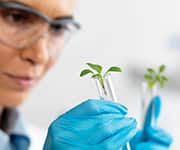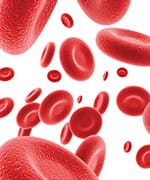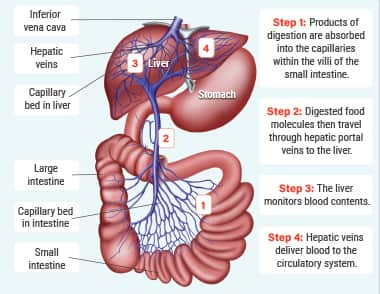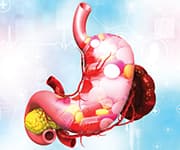Life Extension Magazine®
We receive questions from readers asking about the bioavailability of certain nutrients.
The purpose of these inquiries is to ascertain what can be done to enhance distribution of ingested nutrients into circulating blood.
Some confuse the term absorption with bioavailability.
I simplify the difference as follows:
Absorption is the movement of the nutrient across the first membrane layer of the gastrointestinal (GI) tract.
Bioavailability is how much of the intact nutrient remains in general circulation or reaches the target tissues after going through normal metabolism in the digestive tract, liver, and other areas.
For example, resveratrol is readily absorbed (about 70%) but then undergoes extensive metabolism in various tissues, including the liver.1,2
Last month we described a bioavailable resveratrol that delivered up to 10-times more resveratrol to circulating blood compared to unformulated resveratrol.3
Curcumin is one of the most extensively studied plant extracts. Over 4,000 published reports describe its potential benefits on the National Library of Medicine website (www.pubmed.gov).
The challenge is that curcumin undergoes many changes before and after reaching the bloodstream. These alterations reduce the bioavailability of the beneficial curcuminoids.4,5
The good news is that over the past four decades, improvements have been made that substantially increase curcuminoid bioavailability.6
Consumers are often unaware of the differences in absorption and bioavailability of the many brands available today.
This editorial succinctly describes the fascinating topic of nutrient bioavailability.
A little-understood factor that contributes to human health relates to nutrient bioavailability.
As scientists attempt to evaluate the longevity impact of dietary supplements, the need to better understand bioavailability becomes strikingly apparent.
This was easy with compounds like coenzyme Q10 (CoQ10) for which several enhanced absorption techniques were developed. 7-10 One form, called ubiquinol, demonstrated improved tissue bioavailability and provided clinical data to support beneficial dose-response effects in heart failure patients.11,12
Improving the bioavailability of plant extracts is more challenging than doing so for CoQ10. That is because factors in the digestive tract, liver, and other tissues break down and influence the structure of plant compounds after oral ingestion and absorption.
The potential role of plant extracts in reducing the incidence of degenerative illnesses is significant, requiring continued evaluation of their effects on healthy longevity and improving bioavailability.
Search for Bioavailable Fisetin and Quercetin
Published data support beneficial effects of quercetin in humans, even though relatively little intact quercetin makes it into the bloodstream.13-15
Like many plant flavonoids, dietary quercetin suffers from poor oral bioavailability.
Consumers today want more consistent circulatory delivery of plant compounds.
Favorable lifespan data on fisetin may be more compelling than on quercetin.
But, a series of reactions in the digestive tract and liver rapidly metabolize fisetin before meaningful amounts of intact fisetin can enter the blood.16
Solutions Using Plant-Derived Ingredients
Scientists have discovered that by combining fisetin with a compound isolated from the herb fenugreek, it is protected from being metabolized in the liver. It remains active and can be readily transported intact into the bloodstream.16
Researchers found that a formulated fisetin-fenugreek fiber combination increased fisetin bioavailability (absorbed and circulating) in humans up to 25 times compared to unformulated fisetin. 16
For quercetin, encasing it in a phosphatidylcholine complex increased bioavailability by 50-times more compared to standard quercetin.17
These bioavailability enhancements enable people to derive more consistent blood levels of nutrients that have demonstrated protective benefits.
Overcoming Curcumin’s Challenges
Curcumin functions via multiple mechanisms to reduce the risk for a range of age-related problems.18-20
The challenge is that intact curcumin compounds are poorly absorbed into the bloodstream.5
To garner maximum benefits, better forms of curcumin were needed to deliver more active “free curcuminoids” into circulating blood.
Several years ago, a curcumin formulation was developed that is better protected against changes in the intestines and the liver that limit systemic benefits.21
This curcumin-fenugreek formula was shown to deliver the highest amounts of free (active) curcuminoids into the bloodstream and the broadest tissue distribution including to the brain, liver, kidney, heart, and spleen.21
A randomized, double-blind, crossover trial of 50 healthy adults using this novel curcumin formulation revealed a 45.5-fold increase in total plasma free-curcuminoids versus standardized turmeric powder.
A remarkable 70% of these plasma curcuminoids remained in their active free form five hours after dosing.6
This goes a long way to satisfying those who appreciate the value of plant compounds in human health but seek reliable data on greater bioavailability and broader tissue distribution.
Understanding Bioavailability
Absorption happens when nutrients pass through the cell membranes of the lining of the digestive tract into blood or lymph capillaries.
Bioavailability has several definitions, but a common theme relates to the amount of intact nutrient that reaches general circulation or the site of action.
The two biggest factors impacting bioavailability are how well the nutrient holds up during metabolism (e.g., sulfation, glucuronidation) in other layers of the intestinal tract and its first pass through the liver.22
The first pass effect or metabolism refers to how much metabolic breakdown of an oral agent occurs in the intestine or liver before it reaches systemic (blood) circulation.
More of the nutrient will be bioavailable in circulating blood if it bypasses the first pass metabolism.
Hepatic (Liver) Portal System
This graphic shows blue veins emanating from the intestines merging into the portal vein in the liver.
The hepatic (liver) portal system is a series of veins that carries ingested/absorbed nutrients from the digestive tract to the liver for metabolism.
Absorption from the intestinal tract and metabolism by the liver have major impacts on nutrient bioavailability.
New Opportunities!
The data conveyed in this editorial have transformative implications as they relate to neutralizing multiple mechanisms contributing to age-related ailments.
As more bioavailable forms of fisetin, quercetin, resveratrol, and curcumin emerge, people today can garner health benefits that were previously limited to laboratory models.
Unlike exorbitantly priced prescription drugs, bioavailable plant-based formulations often cost less because they more efficiently achieve greater blood levels.
I want to thank our group of longevity enthusiasts for their continued support via their purchases of blood tests and supplements.
Proceeds enable us to help fund a range of research projects aimed at delaying and reversing biological aging in people.
For longer life,
William Faloon
References
- Walle T, Hsieh F, DeLegge MH, et al. High absorption but very low bioavailability of oral resveratrol in humans. Drug Metab Dispos. 2004 Dec;32(12):1377-82.
- Springer M, Moco S. Resveratrol and Its Human Metabolites-Effects on Metabolic Health and Obesity. Nutrients. 2019 Jan 11;11(1).
- Joseph A, Balakrishnan A, Shanmughan P, et al. Micelle/Hydrogel Composite as a “Natural Self-Emulsifying Reversible Hybrid Hydrogel (N’SERH)” Enhances the Oral Bioavailability of Free (Unconjugated) Resveratrol. ACS Omega. 2022 Apr 19;7(15):12835-45.
- Pandaran Sudheeran S, Jacob D, Natinga Mulakal J, et al. Safety, Tolerance, and Enhanced Efficacy of a Bioavailable Formulation of Curcumin With Fenugreek Dietary Fiber on Occupational Stress: A Randomized, Double-Blind, Placebo-Controlled Pilot Study. J Clin Psychopharmacol. 2016 Jun;36(3):236-43.
- Metzler M, Pfeiffer E, Schulz SI, et al. Curcumin uptake and metabolism. Biofactors. 2013 Jan-Feb;39(1):14-20.
- Kumar D, Jacob D, Ps S, et al. Enhanced bioavailability and relative distribution of free (unconjugated) curcuminoids following the oral administration of a food-grade formulation with fenugreek dietary fibre: A randomised double-blind crossover study. Journal of Functional Foods. 2016;22:578-87.
- Hosoe K, Kitano M, Kishida H, et al. Study on safety and bioavailability of ubiquinol (Kaneka QH) after single and 4-week multiple oral administration to healthy volunteers. Regul Toxicol Pharmacol. 2007 Feb;47(1):19-28.
- Bhagavan HN, Chopra RK. Plasma coenzyme Q10 response to oral ingestion of coenzyme Q10 formulations. Mitochondrion. 2007 Jun;7 Suppl:S78-88.
- Langsjoen PH, Langsjoen AM. Comparison study of plasma coenzyme Q10 levels in healthy subjects supplemented with ubiquinol versus ubiquinone. Clin Pharmacol Drug Dev. 2014 Jan;3(1):13-7.
- Zhang Y, Liu J, Chen XQ, et al. Ubiquinol is superior to ubiquinone to enhance Coenzyme Q10 status in older men. Food Funct. 2018 Nov 14;9(11):5653-9.
- Langsjoen PH, Langsjoen AM. Supplemental ubiquinol in patients with advanced congestive heart failure. Biofactors. 2008;32(1-4):119-28.
- Mortensen SA, Rosenfeldt F, Kumar A, et al. The effect of coenzyme Q10 on morbidity and mortality in chronic heart failure: results from Q-SYMBIO: a randomized double-blind trial. JACC Heart Fail. 2014 Dec;2(6):641-9.
- Chekalina NI, Shut SV, Trybrat TA, et al. Effect of quercetin on parameters of central hemodynamics and myocardial ischemia in patients with stable coronary heart disease. Wiad Lek. 2017;70(4):707-11.
- Javadi F, Ahmadzadeh A, Eghtesadi S, et al. The Effect of Quercetin on Inflammatory Factors and Clinical Symptoms in Women with Rheumatoid Arthritis: A Double-Blind, Randomized Controlled Trial. J Am Coll Nutr. 2017 Jan;36(1):9-15.
- Rich GT, Buchweitz M, Winterbone MS, et al. Towards an Understanding of the Low Bioavailability of Quercetin: A Study of Its Interaction with Intestinal Lipids. Nutrients. 2017 Feb 5;9(2).
- Krishnakumar IM, Jaja-Chimedza A, Joseph A, et al. Enhanced bioavailability and pharmacokinetics of a novel hybrid-hydrogel formulation of fisetin orally administered in healthy individuals: a randomised double-blinded comparative crossover study. Journal of Nutritional Science. 2022;11:e74.
- Riva A, Ronchi M, Petrangolini G, et al. Improved Oral Absorption of Quercetin from Quercetin Phytosome(R), a New Delivery System Based on Food Grade Lecithin. Eur J Drug Metab Pharmacokinet. 2019 Apr;44(2):169-77.
- Shakeri A, Cicero AFG, Panahi Y, et al. Curcumin: A naturally occurring autophagy modulator. J Cell Physiol. 2019 May;234(5):5643-54.
- Campbell MS, Berrones AJ, Krishnakumar IM, et al. Responsiveness to curcumin intervention is associated with reduced aortic stiffness in young, obese men with higher initial stiffness. J Funct Foods. 2017;29:154-60.
- 20.
Zendedel E, Butler AE, Atkin SL, et al. Impact of curcumin on sirtuins: A review. J Cell Biochem. 2018 Dec;119(12):10291-300. - Im K, Maliakel A, G G, et al. Improved blood–brain-barrier permeability and tissue distribution following the oral administration of a food-grade formulation of curcumin with fenugreek fibre. Journal of Functional Foods. 2015;14:215-25.
- Pressman P, Clemens RA, Hayes AW. Bioavailability of micronutrients obtained from supplements and food. Toxicology Research and Application. 2017;1:2397847317696366.







